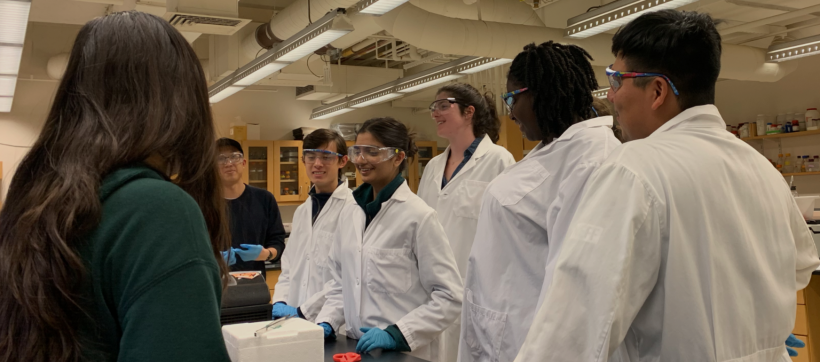20.109(S20):Treat cells with etoposide and analyze RNA-seq data (Day2)
Contents
Introduction
In this module, you will assess gene expression using two methods: quantitative PCR (qPCR) and RNA-seq. For timing reasons you will not be able to prepare and submit your treated samples for RNA-seq. Instead you will use RNA-seq data generated by the teaching faculty. You will, however, complete the same procedure used by the teaching faculty to prepare the RNA samples and then use your samples in a qPCR experiment to confirm the RNA-seq results.
To begin your assay, you will first induce DNA damage by incubating your cells with etoposide. Etoposide is a chemotherapy drug that generates DNA strand breaks by forming a ternary complex with DNA and topoisomerase II. This prevents religation of the DNA strands after unwinding. This effects cancer cells more than non-cancerous cells because cancer cells divide much faster. We will use etoposide to damage the DNA then examine the transcriptome of DLD-1.
Protocols
Part 1: BE Communication Lab workshop
Our communication instructors, Dr. Sean Clarke and Dr. Prerna Bhargava, will join us today for a workshop on preparing and organizing your Journal Club presentations.
Part 2: Induce DNA damage
In this exercise, you will induce DNA damage in cells that were seeded by the teaching faculty (using the cells you seeded during the previous laboratory session). Next class you will purify RNA from your cells for quantitative PCR analysis. Control, no treatment flasks will be taken care of by instructors.
- Prepare your working space within the tissue culture hood.
- Calculate the volume of etoposide stock needed for DNA damage induction.
- Obtain an aliquot of pre-warmed media from the 37 °C water bath.
- Transfer 10 mL of the media into a 15 mL conical tube.
- Determine the volume of etoposide stock (100 mM) you need to add to the media for a final concentration of 100 μM in the 10 mL aliquot.
- Prepare your media +etoposide.
- Retrieve two T75 flasks (one DLD-1 culture and one BRCA2-/- culture) from the 37 °C incubator and visually inspect your cells with a microscope.
- Record your observations concerning media color, confluency, etc. in your laboratory notebook.
- Move your flasks into the tissue culture hood.
- Aspirate the spent media from each flask.
- Be careful not to cross-contaminant between flasks with different cell lines!
- Add 5 mL of PBS to each flask and rock the plate gently to wash the cells.
- Aspirate the PBS from each flask.
- Again, be careful not to cross-contaminate.
- Add 5 mL of the media containing etoposide that you prepared in Step #2 to the flasks.
- Carefully move the 'etoposide treated' flasks to the 37 °C incubator for 60 min.
- Assist your partner if they are still working. When you are both done, return to the main laboratory space.
- Return to the tissue culture space and retrieve your flasks from the 37 °C incubator.
- Aspirate the media containing etoposide from each flask.
- Be mindful of cross-contamination.
- Add 10 mL of fresh media to each flask.
- Label the flasks containing the DLD-1 and one BRCA2-/- cultures that were treated with etoposide with '+etop' to denote that the cells were treated with only etoposide.
- Move these flasks to the 37 °C incubator.
- Assist your laboratory partner, if necessary, then clean the hood and return the main laboratory space.
Part 3: Analyze RNA-seq data
Reagents
- etoposide, stock = 100 mM (Sigma-Aldrich)
Next day: Purify RNA from etoposide-treated cells and generate cDNA
